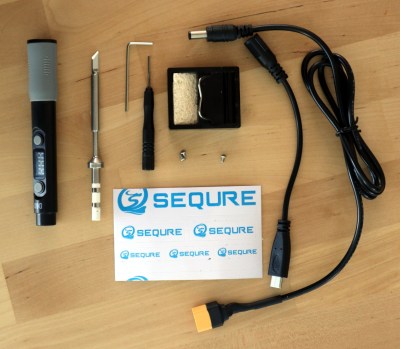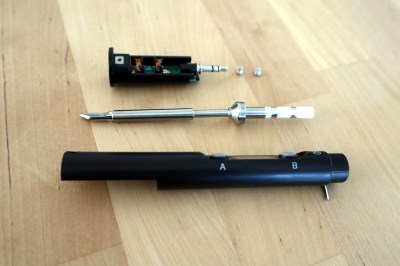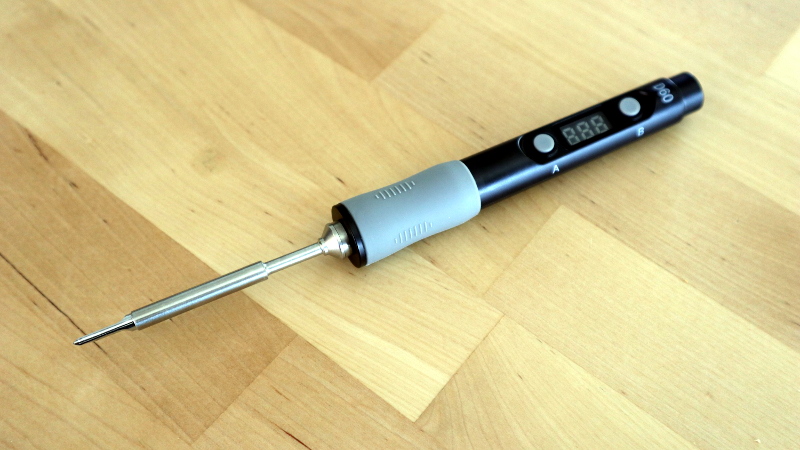Over the past few years a new class of soldering iron has arisen: a temperature controlled iron no longer tied to a bulky mains-powered base station, but using low-voltage DC power and with all electronics concealed in a svelte handle. First came the Miniware TS100, and then many more, with slightly different feature sets and at varying price points. We’ve reviewed a few of them over the years, and today we have the most recent contender in the Sequre SQ-D60. It follows the formula closely, but costs only £20 (about $26). This price puts it in an attractive budget category, and its USB-C power option makes it forward-looking over models with barrel jacks. Description over, it’s time to plug it in and put it through its paces.
What’s In The Box?

In the box, aside from the handle containing the electronics, were a surprisingly comprehensive array of parts and accessories. The handle itself is similarly-sized to its competitors, being only slightly longer than that of Pine64’s Pinecil. The tip supplied was unexpectedly a slanted chisel, so I may have managed to order incorrectly, though since it shares the same tip design as both the TS100 and the Pinecil I have plenty of alternative tips should I need one. Otherwise there was a little bag of hex screws along with a key and a driver for them, a little stand with a sponge, a set of Sequre stickers, a USB-C to barrel jack cable, and a barrel jack-to-XT60 connector for use with LiPo battery packs. These last two cables are a particularly useful addition.
At first sight the tip doesn’t seem to have any means of being fixed into its socket, but a closer inspection reveals that there is a hex screw hiding underneath a silicone finger sleeve that holds it securely when tightened. The handle has a simple enough interface, with just two buttons and a 3-digit, 7-segment display. Powering it up from a 45 W USB-PD power supply, and it heats up to 300 °C in around ten seconds after pressing one of the buttons. My usual soldering temperature is 360 °C, and it has an interface involving long presses of one of the buttons before they become up and down buttons to select the temperature. In prolonged use the handle doesn’t become noticeably warm, and aside from a slight new-electronics-getting-hot smell there was no immediate concern that it might release magic smoke.
An Iron Like Several Others

In use, it’s remarkably similar to the other irons we’ve looked at of similar size and shape. Soldering is straightforward, it’s light and easy to use with plenty of heat. The instruction leaflet has a blow-up diagram of its internals, but it pains me to admit that this iron provided a rare moment in which my tear-down skills were defeated. Unexpectedly the tip is mounted to a sub-assembly that comes away from the main board with a 3.5mm jack, and while this was easy to remove, it proved almost impossible to slide the main board out of the handle tube. The reason was that the two silicone buttons would foul on the display and would not budge despite a lot of coaxing. I could have revealed the board by intentionally destroying either buttons or display, but since I prefer to keep the iron useful I didn’t do that. If similar irons are anything to go by I would expect it to contain a USB-PD chip, an 8-bit microcontroller because it has none of the firmware upgradeable features of the TS100 or Pinecil, and then a MOSFET to control the tip. It’s a tested and reliable formula for these irons.
Should you buy one? If you’re looking for a mini iron with a reasonable feature set and some really useful cables bundled all at a budget price, yes. It’s not as cheap as the super-budget SanErYiGo SH72 that we reviewed early last year, but unlike that iron it has digital control and USB-C. Compare it with the old reliable TS100 and the super-hackable Pinecil, and make up your own minds.















“would expect it to contain a USB-PD chip, an 8-bit microcontroller because it has none of the firmware upgradeable features of the TS100 or Pinecil”
The product page that is in the article actually says it has a STM32 mcu. I guess they just didn’t bother with the firmware update parts and just copied and existing fw.
In this day and age, it is getting harder and harder to ferret out the difference between an honest review and paid promotional content. I think HaD should be a leader in this effort.
I’m going to suggest that when review like this are posted that you make standard “disclosure” block that outlines the details under which the review was made. Include details such as: did you pay for the product, do you get to keep the product, where you paid to write the review, etc. I don’t think it will incur much extra effort, but could really show others that this is important.
Hackaday does not publish sponsored content or paid reviews. In this case Jenny bought this iron herself. We do sometimes receive sample units for review and we always disclose that. Read more here: https://hackaday.com/policies/#editorial-policy
My point was that others might not realize this. I guess I wish that there was a “editorial-policy” icon akin to the Creative-Commons icons.
Sorry if I am projecting, I might have lingering grumblings because of a recent review from .
Nathan, your point is well taken.
Mike, it only makes you and the HaD team look better by putting at “we purchased this with our own money” sentence at the top of the article!
a
Agreed. Having that information on the page would also deter inflammatory comments.
This is hardly Boris and his makeover.
I bought this iron for myself. Please take my assurance, should someone give me something to review, you the readers will be the first to know.
You need to gently pull out the silicone buttons before you can slide out the main board.
Isn’t the TS100 and the Pinecil on the same “super-hackable” level as they both are able to use the same IronOS firmware?
IMO the Pinecil is more hackable because the official breakout board exposes the JTAG, UART and other connections. With the TS100 you need to get access to them using other methods.
1. same thermal-mass response when compared to TS100?
2. setting accuracy and/or repeatability?
3. is there a tip available that is large enough to light my cigar?
Number three is critical – a lit cigar keeps the wife and niece out of my shop.
If you can do without the built-in controller there are 15$ irons that use the less expensive, longer tip cartridges. They also use an external barrel jack (or whatever 12~24 volt feeds).
Although I’d recommend going another 4$ and getting a better iron handle than the PCB based one they usually ship with.
Since, after shipping, this iron is exactly the same price as a Pinecil, I honestly don’t see any reason why one would choose this over a Pinecil.
It takes TS-80 and TS-100 tips, apparently. I can’t understand why they went with that adapter, but there it is.
So does the PineCil, they’re all the same tips. Having just received my PineCil the only advantage I can see is that you might be able to actually get this one, the PineCil keeps getting made in such small batches that I had to set a scraper alert on the website to see when it was back in stock as it sold out again immediately.
Seems like it costs more, at least for the nicer model that allows you to set an arbitrary temperature. The less-expensive model has three settings – low, medium, and high. The pricey one has a display and adjstability.
I am searching for a portable solder iron and a portable digital oscilloscope.
I read this article about this solder iron but I am unable to decide. Does it work? Is it worth buying? Is there any video with any tests? Is it able to handle THT components?
I am still searching for a suitable oscilloscope. My 2GHz military soviet-era monster is too big and then I turn it on, the power meter acts like the devil got inside.
It might be good enough for you. I have a TS 80p(~85€), which I really like, but the tips are quite expensive. But it has USB c. And I have a pinecil.it uses 100 tips is cheaper 25€, and it can be used with either a power supply or USB c. So I would say buy a pinecil but those are often out of stock (see answers above). But apart from that something with USB c adapter is great. Take a power bank and you can be very easy on the go. (Don’t need all those dangerous rc car batteries).
It works. Maybe the Pinecil and Miniware irons are a bit better.
Scope: I can recommend the Rigol 1054z.
I’m not sure why usb-c is seen as a step forward…
I so agree! A barrel jack is much more portable with the option to clip it to a wide array of power sources, is more repairable if the jack gets damaged, and is more tolerant of foreign contamination. USB-C is simply a no-go for me in a soldering iron
I’ve got my laptop supply with me when I travel. I can put up with 100g of additional pencil-sized soldering iron, especially if that gives me actually a pretty good iron. The additional DC power supply would just be added dead weight for 95% of the places I go, and be much bulkier than the iron alone.
IIRC, the pinecil does have both barrel jack and USB-C, which would make both of us happy.
Easy answer. I don’t have a variable power supply. I don’t have a fitting adapter for my work laptop power supply or an additional dongle for an old magsafe power supply. I also don’t have all those fancy rc car batteries, which have to be charged and stored in a fireproof bag. But what I have is a cheap and easy usable USB c power bank. Of course the port is not as great and you need a really beefy power supply for USB c to make it work. But it is much easier to travel or work at home, on the balcony, in the garden. Just my powerbank and go. Also the ts80p included a silicon USB c cable so it doesn’t burn up.
In the end the best of my world and your world might be the pinecil. USB c and a power supply adapter.
You can have one 2.7″x2.7″x1.1″ 60W PD wall brick and (though not all simultaneously):
-charge a phone
-charge a laptop
-power a soldering iron
-charge a powerbank
And then you can do the first three via the fourth. And you can do this anywhere with wall AC.
I’ve loved just being able to hook my pinecil up to a USB-C cable I already have handy. One less thing I have to crawl under my desk to plug in or cable to manage indefinitely.
Why wouldn’t it be?
Completely worthless. The set screws to hold the tip tight are cheap and neither of the two hex head Allen wrenches included will tighten enough to allow heat up without putting constant side pressure to keep strong contact with replaceable tip. Also sae or metric will not work by trying the next larger size. It’s so low quality of materials that it doesnt even matter if they had intentions to compete and upgrade from others.
You must be thinking of a different iron – the electrical contact is not made through the screw, and the heating element is *in* the tip. The screw really just serves the purpose of not letting the whole heating element/tip assembly fall out of the handle.
I used from 1974 a Philips mini, and probably I should am still using it but industry decides to not produce anymore tips for it, so I migrated to an Hakko and buy several replacement tips for future. So, a question that always as at myself when I see new products in soldering is: which tips use? Are these tips easily available in future?
Well seems they provide customer with many kinds of replacement tips. You can go ask Sequre customer service.
Good review Jenny!!! Personally I own one this D60B soldering iron. I decided to buy it because I saw a lot of reviews on YouTube to recommended it. I have used it for about 1 years, and it works still very well.
Could anyone please explain the logic behind using a flimsy usb-c connector and a short usb-c to barrel wire, instead of just connecting the barrel connector directly to the soldering iron?
To answer myself – sort of.
I bought one, and it is a really nice soldering iron, and it is a really stupid choice of connection.
Using a USB-C connector for something that you move around as a soldering iron gives a lot of strain on the plug, and to make bad worse, the connection cord is utterly stupid, as it is quite stiff, and thus adds a considerable weight some 20cm behind the iron – very annoying.
If they really did insist on making this conversion cable, then why not make it 1 meter long, and then just a short cable for converting to the XT60 which I probably never are going to use.
It seems like it is hard to disassemble, but I think I some day will make a hack, and replace the USB-C
If the wiring was made more clever, I would say it can compete with the Weller RT, which cost some ten times the prise – and a really shame, as it would cost zero to make the converter cord long, and the battery cord short.
Conclusion, soldering iron: 5 stars, external wiring: 1 star.
I have 1 SQD60. It works great, heats up quite fast even when using a lower power supply.
I just received one, and the screws are too short to hold the tip in, also the tools don’t properly fit the screws.
other than that it seems ok, but the screw thing is annoying!
Were you able to power it with a USB-C PD charger? I think the support of PD is a scam… None of my chargers work with it.
I have also tried with two Lenovo laptop USB-C chargers with no luck, so you are probably right.
Which leads us back to what I earlier claimed, that the use of USB-C is plain stupid – instead this otherwise really nice soldering iron should have either a standard barrel connector, or simply 1m of soft cord without any plugs at all (and of course it should be easy to open, in case the cord needs to be replaced.)
No luck here either and I’ve yet to see anyone who has got it working. Hackaday should update this review.